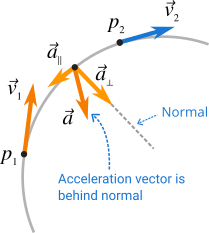The rate of change of velocity vector is called acceleration vector. In straight-line motion, you may have neglected the vector nature of acceleration. It's not your fault, it happens! It's because, the motion was along a straight line and negative acceleration means the particle is slowing down and positive acceleration means the particle is speeding up.
You are not even required to think about vector nature of acceleration for straight-line motion. You could simply subtract velocities to find the acceleration. In two or three dimensional motion the quantities displacement, velocity and acceleration are not along a straight line and it's where their vector nature is essential. But do not forget the vector nature of these quantities even in straight-line motion!
If only the direction of velocity changes not magnitude there is still acceleration. Consider a particle is moving in a curved path (see in Figure 8). When a particle moves in a curved path, both of its magnitude and direction can change. The magnitude of velocity at any point is the speed at that point.

The velocity in Figure 8 at point \({{p}_1}\) is \(\vec{v}_1\) and at point \({{p}_2}\) is \(\vec{v}_2\). The change in velocity is \(\vec {\Delta v} = {\vec v _2} + ( - {\vec v _1}) = {\vec v _2} - {\vec v _1}\). If the time at \({{p}_1}\) is \({{t}_1}\) and at \({{p}_2}\) is \({{t}_2}\), the time interval during the motion along the curve between the two points is \(\Delta t = {t_2} - {t_1}\). Now the average acceleration vector during the motion between the points is
\[{{\vec{a}}_{\text{av}}}=\frac{\Delta \vec v}{\Delta t} \tag{6} \label{6}\]
When the time interval \(\Delta t\) approaches zero the average acceleration vector in Equation \eqref{6} the acceleration vector is now instantaneous acceleration vector . Note that we call instantaneous acceleration vector simply acceleration vector.
\[{{\vec{a}}_{\text{ins}}}=\vec{a}=\underset{\Delta t\to 0}{\mathop{\lim }}\,\frac{\Delta \vec v}{\Delta t}=\frac{d\vec{v}}{dt}\]
You know that the direction of the average acceleration vector is the same as the direction of \(\Delta \vec v\). In Figure 1 notice that the direction of the average acceleration vector is directed (as indicated by the direction of \(\Delta \vec v\)) to the inside of the curved path.
If a particle speeds up in straight-line motion, the acceleration is positive, that is the acceleration has the same direction as the velocity but if it slows down, the acceleration is negative and has direction opposite to the direction of velocity.
Generally in everyday life situations, we understand "accelerates" as "speeds up" but that's not true in Physics. If a vehicle slows down, there is still acceleration and "accelerates" can also mean "slows down" not only "speeds up". It means this word refers to any situation whenever there is an acceleration.
When the particle moves in a curve, the particle always has acceleration even if it's speed is constant. That's because the direction of velocity is continuously changing. The change in magnitude or direction or both of velocity means there is acceleration. In Figure 1, the speed of the particle is constant and therefore only the direction of the particle is changing and there is still acceleration towards the inside of the curve.

You may have experienced acceleration in straight-line as well as in a curved path. If the bus you are travelling with speeds up you move backward and if it slows down, you move forward. If it goes along a curved road, you move towards the outside of the curve (there is no actual force acting on you however even if you feel you are being pushed or pulled. For more details you may refer Newton's first law of motion and inertial frame of reference).
Any particle moving in a curve or circular path always has acceleration towards the inside of the curve or circle even if it moves with constant speed.
The acceleration vector can be expressed in terms of its x, y and z components in a three dimensional coordinate system, that is
\[\vec a = a_\text{x}\hat i + a_\text{y}\hat j + a_\text{z}\hat k\]
and, \(a_x = {dv_x}/{dt}\), \(a_y = {dv_y}/{dt}\) and \(a_z = {dv_z}/{dx}\). The rate of change of velocity is acceleration, so the component of acceleration is the rate of change of corresponding component of velocity.
What are the components of acceleration vector?
You already represented an acceleration vector in components form as x, y and z-components in three dimensional coordinate system but this time we impose a different way to represent the components of an acceleration vector, namely parallel and perpendicular components. This is often found to be easy and useful way to represent the components of an acceleration vector.


The parallel component of acceleration vector is the component that is parallel to the velocity vector and the perpendicular component is the component perpendicular to the velocity vector. If a particle moving in a circular path is either speeding or slowing down, the particle has both components of acceleration (see Figure 2 and Figure 3). If a particle is moving with constant speed in a circle or curve, it only has the perpendicular component of acceleration vector (direction of velocity vector changes continuously) and does not have a parallel component (see Figure 4).

You can easily understand from the above figures that if a particle is speeding up in a curve, the acceleration vector is ahead of normal, and if it is slowing down, the acceleration vector is behind the normal. But if the particle is moving with constant speed, it only has perpendicular component of acceleration vector and the acceleration vector coincides with the normal. Note that the acceleration vector of a particle moving in a curve or circle always points towards the inside of the curve.





